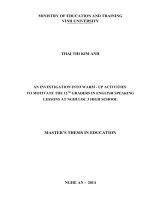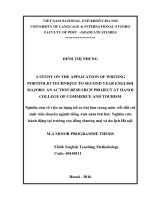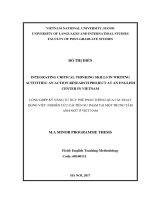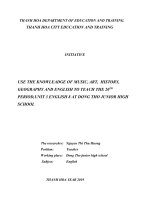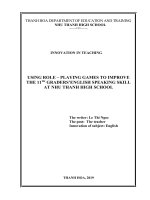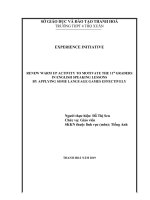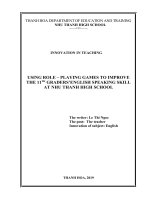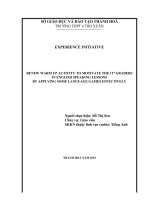Using warm up activities to raise the interest in speaking classes of the 11th graders an action research project at nguyen duc thuan high school
Bạn đang xem bản rút gọn của tài liệu. Xem và tải ngay bản đầy đủ của tài liệu tại đây (981.13 KB, 64 trang )
VIETNAM NATIONAL UNIVERSITY, HANOI
UNIVERSITY OF LANGUAGES AND INTERNATIONAL STUDIES
FACULTY OF POST-GRADUATE STUDIES
*******************
ĐỖ THỊ MAI HƯƠNG
USING WARM–UP ACTIVITIES TO RAISE THE INTEREST IN
SPEAKING CLASSES OF THE 11TH GRADERS: AN ACTION
RESEARCH PROJECT AT NGUYEN DUC THUAN HIGH SCHOOL
(Sử dụng các hoạt động khởi động để tạo hứng thú trong giờ học nói
cho học sinh lớp 11: Một nghiên cứu hành động tại trường
THPT Nguyễn Đức Thuận)
M.A. MINOR PROGRAMME THESIS
Field: English Teaching Methodology
Code: 60140111
HÀ NỘI – 2016
VIETNAM NATIONAL UNIVERSITY, HANOI
UNIVERSITY OF LANGUAGES AND INTERNATIONAL STUDIES
FACULTY OF POST-GRADUATE STUDIES
*******************
ĐỖ THỊ MAI HƯƠNG
USING WARM–UP ACTIVITIES TO RAISE THE INTEREST IN
SPEAKING CLASSES OF THE 11TH GRADERS: AN ACTION
RESEARCH PROJECT AT NGUYEN DUC THUAN HIGH SCHOOL
(Sử dụng các hoạt động khởi động để tạo hứng thú trong giờ học nói
cho học sinh lớp 11: Một nghiên cứu hành động tại trường
THPT Nguyễn Đức Thuận)
M.A. MINOR PROGRAMME THESIS
Field: English Teaching Methodology
Code: 60140111
Supervisor: Assoc.Prof. Nguyễn Văn Độ
HÀ NỘI – 2016
STATEMENT OF AUTHORSHIP
I hereby declare that this thesis is my own work and effort and that has not
been submitted anywhere for any award. I certify that the thesis “Using warm-up
activities to raise the interest in speaking classes of the 11th graders: An action
research project at Nguyen Duc Thuan High School” is the result of my own
study and that it has not been submitted to any other university or institution
wholly or partially.
: Hanoi, 2016
ĐỖ THỊ MAI HƯƠNG
i
ACKNOWLEDGEMENTS
First of all, I would like to express my most sincere gratitude to
Assoc.Prof Nguyen Van Do, my honorable supervisor for his great guidance and
encouragement without which the study would not be completed. His patience
and the amount of time he spent on revising manuscripts with muddled up
contents have been truly appreciated. Besides, his sense of thoughtful criticism
and recognition of the work have played a crucial role to the progress and
completion of this study.
I also take this opportunity to express my thankfulness to all of my course
instructors and lecturers of University of Foreign Languages and International
Studies - Vietnam National University, Hanoi for their valuable advice and
suggestions throughout my study.
In addition, I am appreciative of the English teachers and my students of
class 11A and 11C at Nguyen Duc Thuan High School for their wholehearted
cooperation in involving in the lessons and participating in questionnaires which
gave great help to form a significant part of this study.
Last but not least, my heartfelt gratitude goes to all those who have kindly
advised and helped me towards the completion of my study report.
ii
ABSTRACT
In the globalization age today, English assumes as a more and more
important part as a means of international communication than ever. Therefore,
in some recent years, the focus of teaching has been promoting oral skills in
order to respond to the students‟ needs for effective communication.
However, due to some objective and subjective reasons, teaching and
learning English in general and teaching and learning speaking in particular does
not come up to the study aims. How to teach and learn speaking effectively is
still a challenging question to both teachers and students at many high schools in
Vietnam. It is also the question that has inspired me to investigate the use of
warm-up activities to motivate 11th grade students to speak in speaking lessons.
In attempt to increase students‟ motivation in English speaking activities at
Nguyen Duc Thuan High School, the reseaerchers aims to find out the students‟
attitude towards warm-up activities as well as their effectiveness in enhancing
students‟ interest in speaking skill, and the suggestions for teachers to apply
warm-up activities at Nguyen Duc Thuan High School. To find the answers to
these questions, an action research project was carried out through several steps,
using a combination of two data collection instruments: class observation,
students‟ pre-task survvey questionnaire and post-task survey questionnaire. The
result showed that the students‟ interest increased significantly when warm-up
activities were implemented. It is hoped that this thesis will be found of value to
those who have great interest in using warm-up activities in speaking lessons.
iii
TABLE OF CONTENT
STATEMENT OF AUTHORSHIP ..................................................................... i
ACKNOWLEDGEMENTS.................................................................................ii
ABSTRACT ........................................................................................................ iii
LIST OF ABBREVIATIONS............................................................................vii
LIST OF APPENDICES................................................................................. viiii
LIST OF TABLES .............................................................................................. ix
LIST OF CHARTS .............................................................................................. x
PART A: INTRODUCTION............................................................................... 1
1. Rationale of the study ...................................................................................... 1
2. Aims and significance of the study ................................................................. 2
3. Scope of the study ............................................................................................. 3
4. Method and procedure .................................................................................... 3
5. Organization of the study ................................................................................ 3
PART B: DEVELOPMENT................................................................................ 5
CHAPTER 1: THEORETICAL BACKGROUND........................................... 5
1. Speaking skill .................................................................................................... 5
1.1. Definition of speaking ................................................................................... 5
1.2. Significance of speaking ................................................................................ 6
1.3. Characteristics of a successful speaking activity........................................ 7
2. Overview of current teaching and learning ESL learning situation in
Vietnam ................................................................................................................. 8
2.1. Current teaching and learning ESL learning situation in Vietnam ......... 8
2.2. Problems of teaching and learning speaking skill in Vietnam.................. 9
3. Warm-up activities ......................................................................................... 10
2.1. Definition of warm-up activities ................................................................ 10
2.2. Principles of Warm-up Activity ................................................................. 11
iv
2.3. Significance of warm- up activities ............................................................ 12
3. Related studies.............................................................................................. 12
CHAPTER 2: METHODOLOGY .................................................................... 15
2.1. Action research............................................................................................. 15
2.2. The action research procedure ................................................................... 16
2.3. Setting of the study ...................................................................................... 17
2.4. Participants ................................................................................................... 17
2.5. Data collection methods............................................................................... 18
2.5.1.
Survey questionnaires ........................................................................... 18
2.5.2.
Observation ............................................................................................ 18
CHAPTER 3: RESULTS OF DATA ANALYSIS AND DISCUSSION ....... 20
3.1. Data collected from pre-task survey questionnaire ................................. 20
3.1.1. Students raise their great awareness of the importance of speaking
skill ....................................................................................................................... 20
3.1.2. Students show their low interest in speaking skill ................................ 21
3.1.3. Students passively participate in speaking activities ............................ 23
3.1.4. Warm–up activities were not often organized in speaking lessons in
grade 10: .............................................................................................................. 24
3.2. Data collected from post-task survey questionnaire and observation ... 25
3.2.1. Students’ attitude towards warm–up activities ..................................... 25
3.2.1.1. Students show great excitement during warm–up activities ............ 25
3.2.1.2. Warm–up activities help increase students’ motivation during
speaking activities............................................................................................... 27
3.2.2. Students’ high involnement in warm–up activities and speaking
lessons .................................................................................................................. 28
3.2.2.1. Warm–up activities foster students’ participation in the lesson ...... 28
3.2.2.2. Warm–up activities motivate students to involve in speaking
activities within the lesson ................................................................................. 29
v
3.2.2.3. Warm–up activities boost the students’ interest in speaking in
general ................................................................................................................. 30
3.2.3. Students highly value the use of warm–up activities in speaking
lessons .................................................................................................................. 31
3.2.4. Students' preferences for the use of warm-up activities....................... 32
3.2.4.1. Students' preference for the use of warm-up activities ..................... 32
3.2.4.2. Students' expectation for the use of warm-up activities .................... 33
PART C: CONCLUSION.................................................................................. 34
1. Recapitulation................................................................................................. 34
2. Recommendations .......................................................................................... 35
3. Limitation and suggestion for further study ............................................... 35
REFERENCES ...................................................................................................37
APPENDIX I......................................................................................................... I
APPENDIX II ................................................................................................. VIII
APPENDIX III................................................................................................... IX
APPENDIX IV ................................................................................................... XI
vi
EFL
LIST OF ABBREVIATIONS
English as a foreign language
ESL
English as a second language
vii
APPENDIX I:
LIST OF APPENDICES
SAMPLE GAMES USED IN WARM-UP ACTIVITIES IN
SPEAKING LESSONS
APPENDIX II:
PRE-TASK SURVEY QUESTIONNAIRE
APPENDIX III:
POST-TASK SURVEY QUESTIONNAIRE
APPENDIX IV:
OBSERVATION SHEET
viii
LIST OF TABLES
Table 1: The amount of time spending for practising English speaking outside
classroom
Table 2: Students' participation in warm - up activities
Table 3: Students' participation in speaking lessons
Table 4: Students' interest in speaking skill
ix
LIST OF FIGURES
Figure 1: Students' opinion towards the importance of speaking skill
Figure 2: Students' interest in learning speaking skill
Figure 3: Students' participation in speaking activities
Figure 4: Frequency of using warm - up activities in speaking lessons
Figure 5: Students' feeling while taking part in warm - up activities
Figure 6: Students' feeling after taking part in warm - up activities
Figure 7: Students' expectation for the use of warm - up activities
x
PART A: INTRODUCTION
1. Rationale of the study
In Vietnam, English has earned an increasing attention from different
fields of the society such as technology, science, business, education, and
entertainment. It is also considered as a major means of communication thanks
to its globalization. Therefore, English has become popular and it is taught from
elementary school to higher education. In order to study English, learners need to
attain four language skills: speaking, writing, reading and listening. Among these
skills, speaking seems to be the most crucial for communication process
(Boonkit, 2010) and it can be seen as a bridge to facilitate other skills (see Ur,
1996). In addition to this, speaking can assist students to be better readers,
effective listeners as well as more accurate writers. In a study taken by Nunan
(1991), it was highlighted that success is measured in terms of the ability to carry
out a conversation in the (target) language. Moreover, learners are enabled to
show their feeling or opinions by verbal and non-verbal symbols in different
contexts through oral production (Rahimy & Safarpour, 2012).
It is apparent to realize the importance of speaking skill. However, less
attention has been paid in speaking classrooms at Nguyen Duc Thuan High
School in general and most Vietnamese high schools in particular for the
following reasons. Firstly, most English tests are grammar-oriented. It means that
teachers and students focus mainly on learning and revising grammar structures
and students do not get much chance to practice their speaking skill. As a result,
speaking skill is given less emphasis and seems to be ignored for years and after
graduating from school, students are good at using grammar structures and
vocabulary, but find difficulties to speak English naturally. In addition, in
speaking lessons, students often experience lack of knowlege, words and
expressions needed for speaking or motivation to speak. They even suffer from
shyness or lack of confidence. Thus, arousing students' interest as well as
1
providing them some language preparation is an essential part to prepare for
students to speak. At the beginning, to stimulate students to learn, warm-up
activities should be stressed. The importance of warm up activities in learning
English has been confirmed in many studies. For example, it has been found out
that pre-reading techniques have real impact on the students's motivation to read
(To, 2004) and brainstorming before speaking tasks encourages better learning
(Cullen, 2008). However, practising warm-up activities in a school which has
adopted communicative methods for students is still a new technique and
requires great efforts from teachers. Obviously, there are a lot of warm-up
activities, which are really useful for teachers. The main reasons above lead me to
my choice of the subject: “Using warm-up activities to raise the interest in
speaking classes of the 11th graders: An action research project at Nguyen Duc
Thuan High School”. Hopefully, the success of the research can bring many
benefits for both teachers and learners; reinforce teachers to adopt warm-up
activities frequently in speaking class as well as conduct more studies in this
field.
2. Aims and significance of the study
2.1. Aims and research questions
The major aims of the study are:
1. To explore the effectiveness of using warm-up activities in speaking
lessons of grade 11 in Nguyen Duc Thuan High School.
2. To find out students‟ attitudes towards warm - up activities used in
speaking lessons
With these initial targets, the result is expected to raise implications for teachers
of English, students and educators.
In order to achieve the aforementioned aims, the paper seeks the answers for the
following research questions:
2
1) To what extent can warm-up activities enhance students‟ interest in
speaking class at Nguyen Duc Thuan High School?
2) What are the students‟ attitudes towards speaking lessons before and after
the use of warm-up activities for speaking learning?
2.2. Significance of the study
The study highlights the importance of students‟ interest to the speaking
class and the result of the study also will be used for the author's personal growth
in teaching job. Moreover, the findings of the study might be useful for teachers
who want to enhance their use of warm-up acivities in speaking lessons in order
to raise the student' interest in speaking class.
3. Scope of the study
The study focuses specifically on using warm-up activities in teaching
speaking to the 11th form at Nguyen Duc Thuan High School. So the study limits
itself to the teaching and learning speaking only, and the subjects of the study are
80 students from two classes studying new “Tiếng Anh 11” textbook at Nguyen
Duc Thuan High School.
4. Method and procedure
The method employed in this study is action research, with the use of two
instruments: class observation and the survey questionnaires. The survey
questionnaires including pre-task survey questionnaire and post-task survey
questionnaire is for 80 eleventh graders from two classes of Nguyen Duc Thuan
High School.
The combination of different instruments used in this research would help
to gain reliable data and a close investigation into the problems that students
were having
5. Organization of the study
This paper is divided into three main parts:
3
Part A: Introduction: presents the rationale, the aims, the significance, the scope,
the research method, and the organization of the study.
Part B: Development: includes 3 chapters:
Chapter 1. Theoretical background - provides a theoretical basis for the
study.
Chapter 2. Methodology - includes the methods and procedures used in the
study, which consist of survey questionnaires, and class observation.
Chapter 3. Data analysis and Findings - deal with the findings drawn out
from the analysis of data. The findings and discussion are based on describing
English speaking classes in using warm–up activities in Nguyen Duc Thuan
High School
Part C : Conclusion - includes the recapitulation of the study, limitations of the
study and suggestions for further study.
4
PART B: DEVELOPMENT
CHAPTER 1: THEORETICAL BACKGROUND
1. Speaking skill
1.1. Definition of speaking
Up to now, there are a lot of research on speaking skill so that it contains of
variety definitions of what speaking skill is. In very earlier study by Byrne
(1978), cited in Le (2008), speaking was seen as a process when two or more
learners participate in producing and receiving the target language for
comprehension. Speaking skill was also regarded by Chaney & Burk (1998) as
“the process of building and sharing meaning through the use of verbal and nonverbal symbols, in a variety of contexts”(p.13 cited in Vietnam - Teaching of
English Language). Sharing the same viewpoint, Florez (1999) demonstrated
speaking was “an interactive process of constructing meaning that involves
producing and receiving and processing information.” (Cited in Bailey, 2005, p.
2). It is “often spontaneous, open-ended and evolving”, but it is not completely
unpredictable. In other words, “speaking consists of producing systematic verbal
utterances to convey meaning.” (Balley, 2005, p 2).
Speaking is also referred to as productive skills, (Harmer 1995, in
Temerová, 2007). Bygate (1997) stated that speaking was a skill which deserved
attention every bit as much as literacy skill. It is often thought of as a “popular”
form of expression that uses the unprestigious “colloquial” register. Speaking is
in many ways an undervalued skill. Perhaps this is because we can almost speak,
and so take the skill too much for granted.
In research carried out by Nunan (2003), speaking skill is defined as the
ability speaker can produce English speech sounds, use word and sentence stress,
intonation patterns of target language as well as choose words, phrases and
sentences for specific context of communication appropriately and logically (see
Vietnam - Teaching of English Language). Similarly, in his own view, Mackey
5
(1965) defines “Oral expressions involves not only the use of the right sounds in
the patterns of rhythm and intonation, but also the choice of words and
inflections in the right order to convey the right meaning.” (cited in Bygate,
1997, p. 5). According to him, for the students who want to be good at speaking,
he/ she has to choose the right forms, put them in correct order, sound it like
native speaker and even produce the right meanings. Therefore, speaking skill
generally has to be learnt and practiced carefully before giving a presentation.
In conclusion, speech has its own skills, structures and conventions
different from written language. Speaking skill is one of the key modes of human
communication, and one of the macro skills that language students should be
assisted to develop for their communicative purposes. Because of those reasons,
teachers should help their students to improve their speaking and overall oral
competence.
1.2. Significance of speaking
Speaking is one of the most difficult skills language that learners have to face. In
spite of this, it has traditionally been forced into the background while we,
teachers of English, have spent all our classroom time trying to teach our
students how to write, to read and sometimes even to listen in a L2 because
grammar has a long written tradition (Bueno, Madrid and Mclaren, 2006: 321).
Language is a tool for communication. We communicate with others to
express our ideas, and to know others‟ ideas as well. Communication takes place,
where there is speech. Without speech we cannot communicate with one another.
The importance of speaking skill, hence is enormous for the learners of any
language. Without speech, a language is reduced to a mere script.
Nunan (1991) stated that success in an oral conversation is measured in
terms of the ability to carry out a conversation in the target language. If a student
does not know how to speak and has no chance to speak in the language
classroom, he will lose interest in learning. In the speaking class, on the contrary,
6
if the teacher does not organize right and positive activities, the speaking a
language will become more and more boring.
According to Byrne (1991), while listening and reading are regarded as
receptive skills, speaking and writing are productive skill. Speaking not only
helps students to communicate well and exchange information and culture with
others but also promote the integration of speaking, listening, reading and
writing in the ways that reflect natural language use.
From these points, it is apparent that speaking skill is one of the most
necessary skills in language teaching program. It suits the development rules of
human beings as one can speak before he can read and write. That is the reason
why speaking skill should be taught in the language room.
1.3. Characteristics of a successful speaking activity
There have been many arguments about what a successful speaking activity
is. These following characteristics of a successful speaking activity which
introduced by Ur (1996, p. 120) are accepted:
The first characteristic is that learners talk a lot. It is very important for
teachers to know how to get students talk in the target language as much as
possible in the time of the activity. A speaking activity cannot be considered to
be successful if most of the class time is taken up with the teacher talk or pauses
and very few chances are for students‟ talk when carrying out it.
The second one is high motivation. It is one of the most important criteria
to evaluate a speaking activity. How to create high motivation to students in class
and to make the classroom dynamic is the matter that teachers should pay much
attention to when conducting an activity because it is these factors that lead
students to study effectively. To achieve these, activities used in class must be
interesting, i.e they are in favor of the students, right for students‟ interests, and
they must be carried out in group work, pair work or class work. Teachers of
English, therefore, should be more careful and wholehearted when planning
7
lessons.
The third one is even participation. It means that classroom discussion
attracts equal contribution of all students. Classroom discussion is not dominated
by a minority of talkative participants. All get a chance to speak, and
contributions are fairly evenly distributed. Indeed, uneven partipation may badly
affect the improvement of speaking ability of the students because some worse
students have a few practices and day by day they may loose their confidence.
Last but not least, it is necessary for teachers to remember that language of
speaking activities must be at the acceptable level. In other words, their language
should be relevant to students‟ degree, easily comprehensible to students and of
an acceptable level of language accuracy. Obviously, if the language is too
difficult, students will be afraid and pressed when they try to speak English or
they may not enjoy these activities.
2. Overview of current teaching and learning ESL learning situation in
Vietnam
2.1. Current teaching and learning ESL learning situation in Vietnam
For some recent years, English has played more and more important part in
Vietnam; therefore, it has been taught in Vietnamese high schools as a
compulsory subject. So far, there have been remarkable changes in the way of
teaching and learning English. However, English teaching in general and
teaching speaking in particular still is far from satisfactory. It is claimed that
most schools in the system still pay more attention to English grammar, reading
and vocabulary (Luu, 2011). As a consequence, listening and speaking skills do
not seem to be paid much attention in teachers‟ lesson plans. Thus, English
teaching and learning in Vietnam has strongly remained grammar/examination focused. Indeed, most English exams are composed in order to test students‟
knowledge of grammatical structures and vocabulary more than students‟ all
rounded skills (Luu, 2011).
8
Besides, the interrelationship among four skills consisting of listening,
speaking, reading and writing is not paid much attention in most language
schools in Vietnam. In other words, these four skills are usually taught
separately. Speaking is often taught separately from listening whereas those
skills are integrated skills in real life interaction. As a result, many Vietnamese
students still cannot communicate successfully with foreigners even in simple
daily conversations in spite of the fact that they are good students with high
marks in English tests (Nguyen, 2008)
2.2. Problems of teaching and learning speaking skill in Vietnam
Of the four basic English language skills (listening, speaking, reading and
writing), speaking skill seems to be the most challenging one for most
Vietnamese students.
The first problem might be laid on students‟ and teachers‟ attitudes
towards speaking skill. As for students, there are many problems or difficulties
they have to deal with in speaking skill. In fact, it seems fairly difficult for the
students to exhibit their ideas in front of the class. They are often inhibited about
trying to say things in foreign language: worried about making mistakes, fearful
of criticism or simply shy of the attention that their speech attracts. Therefore,
students might not be interested in speaking skills, which might put a negative
effect on students‟ learning speaking. As for teachers, teachers‟ attitudes towards
speaking somehow are mentioned earlier. Teachers only want to measure the
students‟ speaking skill but not teach it. They just pay more attention to English
grammar, reading and vocabulary. Another point can be seen is that learners
often complain they cannot think of anything to say and they have no motivation
to express themselves. Rivers (1968) believed that the learners have nothing to
express maybe because the teacher had chosen a topic which is not suitable for
him/her or about which he/she knows very little. It is difficult for many students
to respond when the teachers ask them to say something in a foreign language
9
because they might have few ideas about what to say, which vocabulary to use,
or how to use the grammar correctly (Baker & Westrup, 2003). Thus, the
students would have a sense of depression, and they would not be interested in
the lesson
The failure of students in speaking may also originated from the fact that
the teaching and learning process of speaking is not conducted effectively and
the inappropriate teaching method is applied by the teacher. In other words, the
students may find the strategies which the teachers use not interesting and
effective enough to make them motivated and develop their speaking skill.
In short, the factors as described above had an overarching effect on the
teaching practice and teaching outcomes. With a growing demand for English for
communication in the current era, changes are urgently required for the situation.
This necessarily involves change in teachers‟ classroom practice toward
encouraging a more active learning style. In the position I myself of a researcher
consider that warm- up activities applied in speaking lessons, if implemented
appropriately, will help the students promote their positive attitudes towards
speaking skill as well as raise their interest in this skill, which leads to their
improvement in their speaking learning.
3. Warm-up activities
2.1. Definition of warm-up activities
Warm-up activity is a kind of short activities which is used to break the
“ice” in classroom and make it “hot” from the beginning of each period of
language class. They are short, simple and interesting enough to motivate
students to learn a foreign language better. Kay (1995) claims that warm ups are
different types of activities which help the students begin to think in English,
review previously introduced materials and become interested in the lesson (as
cited in Velandia, 2008, p. 11). Therefore, a warm up activity is used to start a
class with an interesting task to help the students be comfortable in classroom
10
setting and get ready for the lesson; and to help them start thinking in English.
2.2. Principles of Warm-up Activity
Adopting warm- up activity in speaking class in particular, in language
class in general is indispensable. However, it may cause bad effects on lessons if
teachers do not follow the principles of using warm- up activities in speaking
class in high school.
Velandia (2008) proposes some principles to design a warm-up activity.
He suggests that a warm-up activity should take place at the beginning of the
class. It will help the teachers catch the students‟ attention. It has to be
interesting so that students get motivated from the very beginning. It is usually a
short activity as it is a preparatory stage of other stages of a lesson. Warm up
activity has to be related with the lesson topic so that in other stages students can
get involved in different activities easily to develop their language skill (p. 13).
Robertson and Acklam (2000) also have described the main features of a
warm-up activity. They include that a warm-up activity needs to be interesting to
motivate the students for practicing English. It will not be the main part of the
lesson as a warm-up activity is a short activity. Warm up can be used to give the
students a chance to revise previously studied language. Robertson and Acklam
(2000) have disagreed with Velandia (2008) that warm up activity has to be
related with the lesson topic. They mention that it is not necessary that warm-up
activity be connected to the lesson as the main purpose of using warm-up
activity is making the students ready to work in English. (p. 8)
In short, to bring into play the effectiveness of warm- up activities in
speaking class as well as in language class, teachers should take these above
principles into consideration before making decision on which activitry is the
best. Surely, it is impossible for teachers to cover all principles at the same time;
this task can be well done if the teacher is very skillful in planning lessons.
11
2.3. Significance of warm- up activities
It is hard to overestimate the importance of a “warm up”. Musicians tune
their instruments up, athletes never sprint until their bodies are prepared, people
in a choir do vocal exercises before singing. Our students, too, need to warm up
into both the target language and being in their groups. Warm- up activities,
therefore, are necessary to make students relaxed, anxiety calmed and ready to
go.
In speaking class, they seem to be more important because it is difficult
for students to start talking in the target language at the beginning of the class.
The necessity of using warm- up activities is obvious.
During teaching period teachers have always wanted to see their students‟
excitement on the lesson everytime they learn English and found out that in
order to achieve this one of the most important things is how to open it. It‟s the
stage where the teacher warmers the language atmosphere and stimulates
students‟ interest from the start of the lesson. Thus it‟s necessary to begin a
lesson with a warmer activity which takes a little time but can bring much effect
on the continuous stages of the lesson.
Therefore, teachers of English should be aware of the importance of warmup activities in speaking class and try to create varied warm- up activities to use
frequently in class time.
Instead of starting a new lesson by checking the previous lesson
mechanically, teachers can use warm- up activities to stimulate students‟ interests
in English, guide them to pay attention to the target language environment and
help them to be well prepared for the new lesson.
3. Related studies
Many studies have investigated the use of warm-up activities in English
language learning classes. Ashia Akther (2014) studied the role of warm-up
activities in language classroom. This study aimed to investigate whether and
12
how often warm up activity is used in tertiary level classes. Also, the study
attempts to find out how effectively warm up is used in the abovementioned
classes. The researcher found that it is helpful to use a warm-up activity in
language classroom. In another study conducted by Zahra Pakdel Estalkhbijari
(2012), the effects of warm-up activities on the Iranian EFL students‟s writing
ability were studied. This study aimed to investigate the effects of warm-up tasks
as classroom activities on foreign language written production. The findings
revealed that participants in the experimental group, who had received the
treatments on warm-up tasks, significantly enhanced better performance in a
writing test.
In the research “ Study on using language games in warm- up activities to
motivate 10th grade students to listen in listening lessons in Duong Xa High
School”, Nguyen Thi Kim Cuc (2010) studied the use of these activities in
listening skill to find out the effectiveness of those warm-up activities in
listening lessons of grade 10. Having the same interest in warm-up activities,
Hoang Thi Du (2010), in “The use of warm-up activities in speaking lessons in
Yen Lang high school: a case study”, aimed to examine the use of warm-up
activities in speaking lessons in Yen Lang high school. The results showed that
all of the teachers use warm-up activities in speaking lessons but their levels of
use were different.
Sharing the same view point, in my present study, I also investigate the use of
warm-up activities in speaking skill. However, the subjects were different with
80 participants - 11th graders who come from Nguyen Duc Thuan High School.
The methodology used in this study is action research with the use of two
instruments: survey questionnaires and observation. In addition, the warm-up
activities are quite different from those used in the above mentioned studies. In
those studies, the warm-up activities were mainly the familiar ones such as
crossword, brainstorming, guessing games, … In my present study, the warm-up
13

